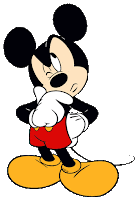Hiaasen and Giroux, two iconic
critics of Disney, have very different approaches in terms of evaluating the
"evil" deeds of Disney and I found both writing styles to be very
thoughtful and entertaining. People may prefer one over the other, and the
reason behind it is the drastic difference between authors' intended
audiences.
The audiences, Giroux wanted to reach are probably people
who value a critical analysis of Disney. Giroux is able to present the broad
picture of Disney and many negative effects of other multimedia corporations.
He provides logical reasoning against the norm of praising Disney's
entertainments, sometimes using statistical facts and sometimes in discussions
of Disney's social responsibility.
Although some languages in Giroux's articles have a spice
in them, the majority of the passages are objective to the point with a
critical view of capitalism market structure.
Hiaasen, on the other hand, perhaps hoped for audiences who
would enjoyed a good laugh or a chill down the spine. He viewed Disney in a
much closer perspective.
Instead of condemning on the capitalism itself, Hiaasen
provides his own fascinations of Disney combining with facts. Using descriptive
wordings, Hiaasen presented a vivid presentation of how Disney shaped the
United States, if not the world. 

Many examples in the book Team
Rodent are author's first-hand experience with Disney, and
these instances bring proximity to reveal the Disney Hiaasen has in mind:
a self-evolving and expanding mouse that slowly rules the world in every
possible angles. Examples of security team chasing teenagers, investigation on
actors' backstage and invitation of journalist to Disney Land reflex just how
powerful and omnipotent Disney can be.
Of course, wordings in the book are meant to attract audiences’
attention and trigger their emotions, but these event are indeed accurate which
is even more repulsive to think about.
Although their intended readers are different, two authors
are excellent in expressing their own believes. However, sometimes opinions in
the readings are too biased which are hard to follow with furious storms
of attack on Disney. Maybe I might not be the intended reader after all.
Both authors have strong arguments and I
appreciate their efforts in evaluating the issues they perceive in Disney. One of
many factors both writers mentioned in their articles is the lack of governmental
regulation which is a fundamental reason behind “accidents” happened in Disney.
As mentioned in Team Rodent, state government granted almost every wish of Disney.
If it were other corporations making deals with government, I can imagine how
difficult it will be for them to gain such a favor. Perhaps Disney’s camouflage
is really working to gain itself advantage over bargains.
After all, I find both writing styles efficient in their
own manner and audiences can have their preferences as well. Giroux’s writing
style is suiting for me because of its logical criticism are clear and dynamic. In
addition, it dives in many fundamental issues we face in America nowadays such
as the rising online social platforms and spreading fever of consumerism toward
children.


No comments:
Post a Comment